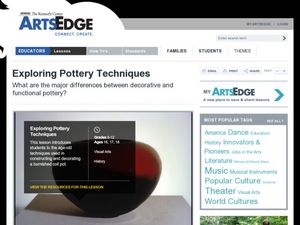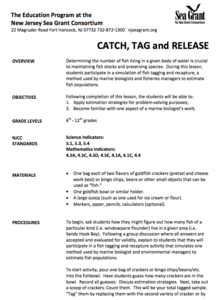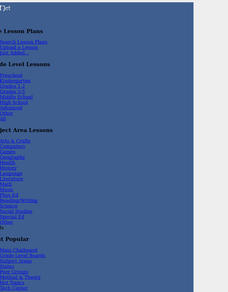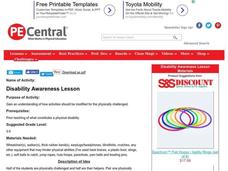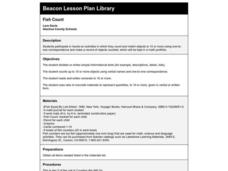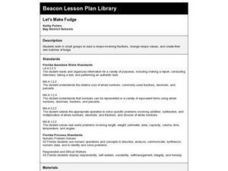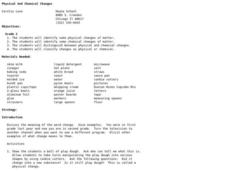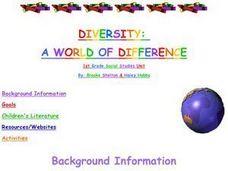Curated OER
Exploring Pottery Techniques
Students examine Native American pottery. In this visual arts instructional activity, students analyze burnished and glazed clay pots. Students study how to create pots from online sources and respond to questions about the process....
Curated OER
The Water Cycle
Students simulate the water cycle. For this water cycle lesson, students create a model of the water cycle. Students draw the water cycle and write a paragraph explaining their drawing.
Curated OER
The Tobacco Time Bomb: What's In A Cigarette?
In this enlightening and disturbing health lesson, students read and discuss information on smoking and closely-look at the ingredients in a cigarette. You will be amazed at the list of ingredients that are found in cigarettes. This...
Curated OER
Catch, Tag, and Release
Learners discover how fish tagging is used by marine biologists and fisheries to estimate fish populations. Participating in a simulation, learners use estimation to determine the whole population from a small number of items.
Curated OER
Alchemists' Theory of the Elements
In this alchemy worksheet, students read about the early thoughts of alchemists regarding elements. Students are given an experiment done by an alchemist during the Middle Ages and they answer three questions about the experiment knowing...
Curated OER
Warm Air versus Cold Air
Students discover that warm air takes up more space than cold air. In this science lesson, students perform 4 experiments using balloons to determine that the molecules of warm air are more spread out than those of cold air.
Curated OER
NYC Muslim Community Center: Why there? Why not?
Students examine religious diversity issues. In this current events instructional activity, students read the provided articles "Sacred Ground or Bridging a Cultural Divide?" "Multiple Views of the Proposed Muslim Center," and "Protests,...
Curated OER
Unraveling the Web
Students consider how a message might be traced along a complex network, then explore backbone maps as a basis for understanding the purpose and structure of the Internet.
Curated OER
Shapes
Students differentiate objects based on contrast in physical characteristics such as color, texture, size and shape. They also recognize and sort objects by color families.
Curated OER
Disability Awareness Lesson
Students gain an understanding of how activities should be modified for the physically challenged.
Curated OER
We're Alike, We're Different!
Students compare a variety of people counters to determine how they're alike and different and then sort, classify and write about how they sort and classify people counters.
Curated OER
Fish Count
Students participate in hands-on activities in which they count and match objects to 10 or more using one-to-one correspondence and make a record of objects counted, which be kept in a math portfolio.
Curated OER
Let's Make Fudge
Students make fudge after reading fractional values in recipes and finding equivalent fractions to those presented in the recipes. They study measurement abbreviations.
Curated OER
Rock Hounds
Students receive a basis for understanding the three main classifications of rock: igneous, sedimentary and metamorphic. They engage in a hands-on activity designed to give them an appreciation for rocks and minerals.
Curated OER
Portrait Sculptures
Third graders identify characteristics that they have in common with animals. They create a self-portrait sculpture combining the body structures of different animals. They create the sculpture armature, plaster the armature, and then...
Curated OER
Art, Naturally
Students read an online article which examine different works of art. They study how patterns and shapes found in nature influence art. Finally, they create original works of art and write artist's statements.
Curated OER
Physical And Chemical Changes
Second graders identify physical and chemical changes of matter. They distinguish between physical and chemical changes. They classify changes as physical or chemical.
Curated OER
California-Becoming an Agricultural and Insustrial Power
Fourth graders explain how California became an agricultural and industrial power. They trace the transformation of the California economy in its political and cultural development since the 1850's.
Curated OER
Soil Recipe
Students examine the components of soil. They work together to use different materials to create their own soil. They make their own dirt cake as well.
Curated OER
Being There: Exploring China And Japan
Learners discover the culture, society, geography, and history of Asia through games, food, art, and literature in this multi-day lesson about China and Japan. An exciting lesson for upper-elementary or lower-middle school classrooms.
Curated OER
Diversity: a World of Difference
First graders each add a different item to a classroom salad while discussing the connection to a multicultural society. They also create a friendship web with yarn by each of them contributing some unique quality about themselves. ...
Curated OER
Edible Four-Layer Earth
This activity is designed to come after students have studied about the four main layers of the earth. They may relate the size of the sections to known objects such as the mantle to the size of a grapefruit and the outer core to the...
Curated OER
Lesson 2 Its a Small World (Day 2)
Students are able to explain how the water cycle recycles the earth's water supply. They are able to make use of the knowledge of land forms learned in social studies. Students are able to form a hypothesis on how/why the water cycle...
Curated OER
Wind and Currents
Students observe how wind generates currents and the effect of islands and banks on currents. They determine ocean circulation affects climate and plant and animal populations on land and in the ocean and that surface currents are...
Other popular searches
- Bowling for Columbine
- Math Bowling
- Bowling Pins
- Bowling Skills
- Bowling Dust
- Bowling Scoring
- Bowling Techniques
- Bowling Alone
- Basic Skills in Bowling
- Bowling Activity
- Bowling Bingo
- Bowling Scores
